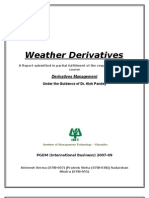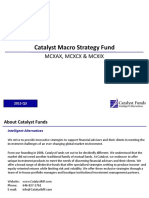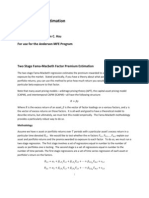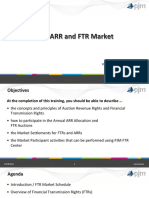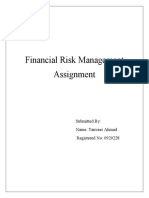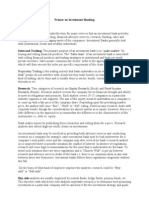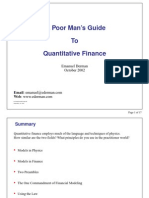Some Applications of Mathematics in Finance (7 November 2008)
Some Applications of Mathematics in Finance (7 November 2008)
Uploaded by
Join RiotCopyright:
Available Formats
Some Applications of Mathematics in Finance (7 November 2008)
Some Applications of Mathematics in Finance (7 November 2008)
Uploaded by
Join RiotOriginal Description:
Copyright
Available Formats
Share this document
Did you find this document useful?
Is this content inappropriate?
Copyright:
Available Formats
Some Applications of Mathematics in Finance (7 November 2008)
Some Applications of Mathematics in Finance (7 November 2008)
Uploaded by
Join RiotCopyright:
Available Formats
Some Applications of Mathematics in
Finance
Robert Campbell
Department of Mathematics and Statistics
wrc@mcs.st-and.ac.uk
Ravenscourt Capital
rcampbell@ravenscourtcapital.com
7
th
November, 2008
Role of a Bank
Intermediates between institutions that want to borrow capital
and institutions that want to lend (invest) capital through
Provision of high-value ideas and financial structures
Provision of efficient trade execution
Bank
Borrowers
Lenders
$/ Ideas $ / Ideas
Structure of an (Investment) Bank
Capital
Markets
Capital
Markets Corporate
Finance
Asset
Management
Technology and Support Services
Quants ~
PhDs
Maths, Physics,
Finance,
Econometrics
Quants ~
MBAs
Quants ~
BSc, PhDs
Finance,Statistics,
Econometrics
Quantitative Modelling within Capital
Markets
Rates
European
Bermudian
American
Path dependent
___________________
Swap Rates
Bond Yields
Mortgages
Interest Rate Volatility
Interest Rate
Correlation
Equities
FX
Credit Commodities
Hybrids
Structured on combination of Rates, Equities, Credit, FX and Commodities
European
Bermudian
American
Path dependent
___________________
Stock Prices
Stock Indices
Equity Volatility
Equity Correlation
European,
Bermudian,
American,
Path dependent
___________________
Commodity Prices
Commodity Volatility
European,
Bermudian,
American,
Path dependent
___________________
FX Rates
FX Volatility
FX Correlation
European,
Bermudian,
American,
Path dependent
___________________
Credit Spreads
Corporate Defaults
Default Correlations
Why are Quants Necessary?
1. Determining value of derivative convexity
Derivative values are non-linear (with respect to underlying asset)
Hedging instruments have linear behaviour
Dynamic (delta-hedging) creates a convexity mis-match
( non-linear derivative vs linear hedge )
2. Tremendous growth in Structured Notes market since 1993
Complex optionality embedded within structured notes
3. Electronic Trading
Investors can now buy $100,000,000 of Government bonds in <1 second by
clicking on various electronic trading portals (e.g. Tradeweb)
Need maintain very tight, accurate and tradable prices that update every 100
milliseconds
Positive and Negative Convexity
Negative Convexity (or Short Volatility)
K
Underlying
Derivative
Delta Hedge
Positive Convexity (or Long Volatility)
K
Underlying
Derivative
Delta Hedge
Learning the different terminologies is
important
Long Convexity
Long Volatility
Long Gamma
Long Vega
Long Optionality
Long Curvature
All mean the same thing!
Assumptions behind Options Valuation
Models
1. Asset prices are log-normally distributed
2. Continuous trading in all quantities
3. No bid-offer spreads or other trading costs (commissions,
taxes, etc)
4. Constant volatility
5. Constant interest rates
Mathematical Model
Asset price process modelled via lognormal stochastic
differential equation
Value of call option is the solution of the terminal value
problem
t t t t
dB X dt X dX o + =
XX t X t t
C X C X rC C
2 2
2
1
) ( o o =
+
= ) ( ) , ( K X T X C
T T
Solution (Blacks Model)
] / ) ( [ ) , , (
t T
rdu
Q
t
K X e E T t X C
T
t
}
=
+
Q
t t t t
dB X dt X dX o o + = ) (
dt dB dB
t
Q
t
+ =
t T d d
t T t T r K X d
d N Ke d N X t X C
t
t T r
t t
=
+ + =
=
o
o o
1 2
2
1
2
) (
1
) /( )] (
2
1
( ) / [ln(
) ( ) ( ) , (
Value, Delta, Gamma, Theta
Vega
Lognormal Distribution typically under
estimates tails
Stock Prices are Not Continuous
( RBS 17
th
April - 23
rd
April 2008 )
Implied volatilities are not constant
Volatility Skews
Implied volatilities constitute a 3-
dimensional surface
There are many measures of volatility
Break-even Volatility
...
2
1
) (
) ( ) , , (
2
+ + + =
+ =
X V t rV rXV V
t V X V r X V t X V P
XX X t
t X t X t t
o o
o o o o o
XX
X t
V X
t rV rXV V
X
X
2
2
2
1
) ( o o +
>
|
.
|
\
|
Buy derivative at V and delta hedge with underlying asset X
=> Long Convexity, short Theta
Change in hedged portfolio over small time interval is
Hedged portfolio makes money if underlying asset moves more than
This is known as the breakeven volatility ( ~ Theta / Gamma )
Traders compute break-even volatility before they put on a trade.
Option value as a Break-even price...
...
2
1
) (
... ) ( ) , , (
2
+ + + =
+ + + + =
X V t rV rXV V
r V V t V X V r X V t X V P
XX X t
r t X t X t t
o o
o oo o o o o o
o
Buy call option at price V and delta hedge with underlying asset X.
Change in hedged portfolio over small time interval is
Zero profit or loss on hedged portfolio over small time interval if
option value satisfies the equation
0
2
1
) (
2
= + + X V t rV rXV V
XX X t
o o
0
2
1
2
2 2
= + +
XX X t
V X rV rXV V o
Break-even Volatility
Example Long Call Option
Spot = 18.00 USD
Strike = 18.00 USD
T = 0.25 years
Log Volatility = 50.00%
Daily break-even stock move must be 0.44 USD (i.e. 44cents)
=> Annualised Stock Volatility ~ 47.3%
If stock moves less that this
Thetadecay andoptioncarry will swampwhat youll makeeverytimeyou
re-balanceyour deltahedge!
Profit and Loss on a Delta-Hedge
...
2
1
) ( ...
2
1
) ( ) , , (
2
2
2
2
+
|
.
|
\
|
=
+ + + + =
+ =
t
X
X
V X
t V X V r X V X V X V t V
t V X V r X V t X V P
I XX
t X t X XX t X t
t X t X t t
o o
o
o o o o o
o o o o o
PnL on a delta-hedge is gamma weighted difference between the realised
volatility and the implied volatility
True PnL must incorporate bid-offer costs
Buy derivative at V and delta hedge with underlying asset X
=> Long Convexity, short Theta
Change in hedged portfolio over small time interval is
Delta Hedging - 1
Realised Volatility > Implied Volatility
Delta Hedging - 2
Delta Hedging - 3
Delta Hedging - 4
Delta Hedging - 5
Forward Rates (3 Month LIBOR)
Interest Rate Derivatives
Typical MarketData Sheet (24Febuary 2007)
Typical Day for a Quant
6:00am-7:45am
Read FT and/or Financial research paper
Read Blackberry messages
7:45-8:15 am
Arrive in office
Look at markets, read recent emails
Check status of any overnight computational batch jobs (usually calibrations)
Get breakfast and eat at desk
(Tokyomarket closing)
8:15am 7:00pm
Continue work on long term modelling projects
Daily / weekly conference call with NY / Tokyo Quant teams (duration typically 1+ hour)
Write up any weekly/monthly research reports
Visit client(s) and give presentation on techniques of option valuation, answer questions and build / strengthen
client relationship
Interview new quants
If quiet, go to corporate gym for hour
React to any client valuation enquiry
E.g. Client wants quote in $500,000,000 for a non-standard structured note by end of business today!
(12noon NY market opening)
Eat lunch at desk
(6pmLondonmarket closing)
Set up any overnight batch jobs that have to be run
Continue to work on any (urgent) client pricing issues
7pm-10pm
Leave office and go home
Dinner with clients / colleagues - either internally (in office) or externally (at restaurant)
Have any follow-up conversations with NY
Read Blackberry messages
(10pmNY market closing)
Typical Capital Markets Trading Floor - Canary Wharf
Daily Interactions of a Quant
Client
Derivative
Structurer
Designs
(Structures) deal
Derivative Trader
Prices Deal
Hedges & manages Risk
Derivative Quant
Creates / mainain Valuation
Model(s)
I ntra-Day I ntra-Day
Occasional
Occasional
System
Technologist
Builds Risk / Valuation
Systems
I ntra-Day
I ntra-Day
Essential attributes of a Quant
Mixture of technical skills and interpersonal skills
Excellent mathematical modelling skills
Ph.D level in (Applied) Mathematics, Physics, Econometrics, Statistics, Finance
Very good programming skills in C++
Ability to deliver implementable solutions within time constraints
Ability to work hard and remain focused and flexible under pressure
Attention to detail, financial intuition / common sense
Mistakes cost money (literally)
Good, intuitive understanding of value
Need to understand complex models and also back of the envelope valuations
Ability to work well as part of a (global) team
Ability to work well on own
Good communication / listening abilities
Ability to reach out and forge working relationships / partnerships across businesses /
geographies
Genuine interest in financial markets
Energy, drive, determination, stamina, common-sense and realism
Career Path of a Quant
0-3 years
Ph.D Associate
Work under close supervision
Learn products / modelling techniques / client base
3-6 years
Vice President
Assume responsibility for products / models
Liaise / work with traders/structures on new product valuation and risk
Speak directly to junior clients
Manage 1-3 junior Quants
6-8 years
Senior Vice President
Assume responsibility for a Quantitative group (e.g. Rates, Credit, FX, etc)
Responsible for new model development / maintenance of existing model
Speak directly to client Portfolio Managers (PMs) and Hedge Fund traders
Manage 3-10 Quants
8-12 years
Managing Director
Assume responsibility for whole / significant part of Quant Research organisation
Responsible for developing strategy for new model development
Products, headcount, technology, clients
Speak to senior clients (Chief Investment Officers, Heads of Fixed Income, etc)
Manage 10-100+ Quants and related staff
Typical Quant whiteboard (Canary Wharf)
10Y CMS Swap
London: + 44 20 7102 4000
New York: +1 212 526 8163
Final Terms and Conditions
15 January 2007
Counterparties
Party A Lehman Brothers Special Financing Inc. (LBSF)
Party B Client
Notional Amount EUR 500,000.000
Trade Date 15 January 2007
Effective Date 31 January 2007
Termination Date 31 January 2017
Party A Payments
101%* 10Y EUR SWAP
Payment Dates 31 January in each year from and including 31 January 2008 to and including the Termination Date
Basis ACT/ACT ISMA
Period End Dates Unadjusted
Business Day Convention Following
Party B Payments 1m Euribor +0.32%
Payment Dates 31
st
in each month in each year from and including 28 February 2007 to and including the Termination Date
Basis Act/360
Period End Dates Adjusted
Business Day Convention Modified Following
Definitions 1m EURIBOR :
With respect to a Calculation Period, the rate for deposits in euros for a period of 1months which appears on Telerate Page 248 as of 11:00 a.m. Brussels time
on the day that is two TARGET Settlement Days prior to the first day of such Calculation Period.
10Y EUR SWAP:
With respect to a Calculation Period the annual swap rate for euro swap transactions with a maturity of 10 years, which appears on the Reuters Screen
ISDAFIX2 Page under the heading EURIBOR Basis - EUR and above the caption 11.00 AM C.E.T. as of 11.00 a.m., Frankfurt time, on the day that is two
TARGET Settlement Days prior to the first day of such Calculation Period.
Business Days London and TARGET
Calculation Agent Party A
Documentation All capitalised terms used in this termsheet and not otherwise defined will have the meanings given to them in the 2000 ISDA Definitions
Quant skills have many applications
Appendix
What are Structured Notes?
Customised financial instrument that pays investor a series of pre-defined
contingent cashflows at agreed dates in the future
Structured Notes enable
Borrowers to access cheaper funding
Investors to access bespoke cashflows that express and monetise their views on the
market
Investment Bank to take a fee for arranging this deal
Everyone is a winner
Cashflows are pre-defined function of underlying reference levels (e.g.
interest rates, FX rates, etc) in the future
Model dynamical evolution of underlying reference levels (e.g. interest rates, FX
rates, etc)
Value using delta-hedging / no-arbitrage techniques
Structure Notes - Cashflows
C
a
s
h
f
l
o
w
D
a
t
e
1
C
a
s
h
f
l
o
w
D
a
t
e
2
C
a
s
h
f
l
o
w
D
a
t
e
3
C
a
s
h
f
l
o
w
D
a
t
e
4
C
a
s
h
f
l
o
w
D
a
t
e
5
(
=
M
a
t
u
r
i
t
y
D
a
t
e
)
S
t
a
r
t
D
a
t
e
Cashflows are pre-defined function of (multiple) underlying reference levels (e.g.
interest rates, FX rates, etc)
So how are Structured Notes actually
created?
Example
Suppose Issuer currently funds at LIBOR flat
Suppose Issue would like cheaper (sub LIBOR) funding
Method
Find investor who wants to monetise a view on market ( e.g. changes in interest
rate/volatility term structure )
Lehman Brothers structures a coupon bearing note that encapsulates this view
Issuers sells note to investor for PAR ( borrowing)
Issuers enters into swap with Lehman Brothers
Issuer repays investor PAR at maturity (re paying)
Investor Issuer
Lehman
Brothers
100
Investor Issuer
Lehman
Brothers
LIBOR +/- Spread
Structured Coupon Structured Coupon
Investor Issuer
Lehman
Brothers
100
Cashflow Structure for a Generic
Structured Note
Swap Cash Flows
Terminal Cash Flow
Initial Cash Flow
10Y Leveraged Callable CMS Steepener
100% Principal Protected Final Terms and Conditions
9 February 2007
London: + 44 20 7102 4000
New York: + 1 212 526 8163
Issuer Lehman Brothers Treasury Co. Bv
Nominal Amount EUR 250,000,000
Trade Date 9 February 2007
Issue Date 9 March 2007
Maturity Date 9 March 2017 (Subject to Issuers Call Option)
Issue Price 100%
Redemption Price 100%
Coupon Rate
Year 1 Year 4: 10Y EUR SWAP + 0.25%
Year 5 Year 10: 16* (10Y EUR SWAP 2Y EUR SWAP) with a minimum coupon of 2% and a
maximum coupon of 10%.
Coupon Payment Dates 9 March in each year from and including 9 March 2008 to and including the Maturity Date
Calculation Period From and including one Coupon Payment Date (or the Issue Date in respect of the first Calculation Period) to but excluding the next
Coupon Payment Date each date being subject to no adjustment
Basis ACT/ACT ISMA
Definitions 2Y EUR SWAP:
With respect to a Calculation Period the annual swap rate for euro swap transactions with a maturity of 2 years, which appears on the
Reuters Screen ISDAFIX2 Page under the heading EURIBOR Basis - EUR and above the caption 11.00 AM C.E.T. as of 11.00 a.m.,
Frankfurt time, on the day that is two TARGET Settlement Days prior to the first day of such Calculation Period.
10Y EUR SWAP:
With respect to a Calculation Period the annual swap rate for euro swap transactions with a maturity of 10 years, which appears on the
Reuters Screen ISDAFIX2 Page under the heading EURIBOR Basis - EUR and above the caption 11.00 AM C.E.T. as of 11.00 a.m.,
Frankfurt time, on the day that is two TARGET Settlement Days prior to the first day of such Calculation Period.
Issuers Call Option:
The Issuer has the right on 9 March of every year starting 9 March 2011, provided that the Issuer gives 5 Business Days notice to
the noteholders, to call the Notes at par.
Business Days London
Business Day Convention Following
Constant Maturity Swaps (CMS Swaps)
Exchange CMS spread for Libor flat
Spread chosen such that NPV of swap is zero
Sensitive to slope of swap curve
Spread is a function of
Steepness of the forward curve
Volatility of the forward curve
Maturity of deal
CMS spread
Libor
Swap
Counterparty
A
Swap
Counterparty
B
2 2
01
01
2
1
Spread T
FV
FV
c
I
= o
Receiving CMS / Paying LIBOR flat
Long convexity/gamma/volatility
Swap value increases with volatility
Paying CMS / Receiving LIBOR flat
Short convexity/gamma/volatility
Swap value decreases with volatility
Constant Maturity Swaps (contd)
CMS Convexity
K Forward
Swap Rate
Forward Starting
Swap
CMS Swap
Constant Maturity Swaps: Valuation Step I
Example: 10Y Swap: Receive 10Y CMS Spread / Pay LIBOR Flat
Compute how much the steepness is worth under a zero volatility assumption
Today: 20-Mar-03 Spread: 0.0 bp
Acc Start &
Fixing Date
Acc End &
Pay Date
Fwd Swap
Rate
Lognormal
Volatility
CMS Cvx
Corr (bp)
CMS
Cpn
CMS Cpn
Spread
Fwd
LIBOR
Discount
Factor
PV CMS
Leg
PV Float
Leg
22-Mar-03 22-Mar-04 4.383 0.00 0.00 4.383 4.383 2.443 0.9756 4.276 2.423
22-Mar-04 22-Mar-05 4.724 0.00 0.00 4.724 4.724 3.023 0.9466 4.472 2.901
22-Mar-05 22-Mar-06 5.017 0.00 0.00 5.017 5.017 3.789 0.9116 4.574 3.502
22-Mar-06 22-Mar-07 5.232 0.00 0.00 5.232 5.232 4.279 0.8737 4.571 3.791
22-Mar-07 22-Mar-08 5.394 0.00 0.00 5.394 5.394 4.612 0.8346 4.502 3.913
22-Mar-08 22-Mar-09 5.52 0.00 0.00 5.52 5.52 4.903 0.7950 4.388 3.952
22-Mar-09 22-Mar-10 5.615 0.00 0.00 5.615 5.615 5.118 0.7558 4.244 3.922
22-Mar-10 22-Mar-11 5.685 0.00 0.00 5.685 5.685 5.333 0.7170 4.076 3.877
22-Mar-11 22-Mar-12 5.726 0.00 0.00 5.726 5.726 5.434 0.6795 3.891 3.754
22-Mar-12 22-Mar-13 5.750 0.00 0.00 5.750 5.750 5.534 0.6434 3.700 3.610
42.694 35.645
Important
At zero spread and zero volatility, swap is worth 7.049 per 100 face
As expected, value of fixed leg is greater than the value of floating leg
This comes from the steepness of the EUR forward curve
Constant Maturity Swaps: Valuation Step II
Important
Zero volatility spread is 86.65 bp
This comes from the steepness of the EUR forward curve
We expect that convexity effects will increase this spread
Acc Start &
Fixing Date
Acc End &
Pay Date
Fwd Swap
Rate
Lognormal
Volatility
CMS Cvx
Corr (bp)
CMS
Cpn
CMS Cpn
Spread
Fwd
LIBOR
Discount
Factor
PV CMS
Leg
PV Float
Leg
22-Mar-03 22-Mar-04 4.383 0.00 0.00 4.383 3.516 2.443 0.9756 3.431 2.423
22-Mar-04 22-Mar-05 4.724 0.00 0.00 4.724 3.857 3.023 0.9466 3.651 2.901
22-Mar-05 22-Mar-06 5.017 0.00 0.00 5.017 4.151 3.789 0.9116 3.784 3.502
22-Mar-06 22-Mar-07 5.232 0.00 0.00 5.232 4.365 4.279 0.8737 3.814 3.791
22-Mar-07 22-Mar-08 5.394 0.00 0.00 5.394 4.528 4.612 0.8346 3.779 3.913
22-Mar-08 22-Mar-09 5.52 0.00 0.00 5.520 4.653 4.903 0.7950 3.700 3.952
22-Mar-09 22-Mar-10 5.615 0.00 0.00 5.615 4.748 5.118 0.7558 3.589 3.922
22-Mar-10 22-Mar-11 5.685 0.00 0.00 5.685 4.818 5.333 0.7170 3.455 3.877
22-Mar-11 22-Mar-12 5.726 0.00 0.00 5.726 4.860 5.434 0.6795 3.301 3.754
22-Mar-12 22-Mar-13 5.750 0.00 0.00 5.750 4.884 5.534 0.6434 3.141 3.610
35.645 35.645
Example: 10Y Swap: Receive 10Y CMS Spread / Pay LIBOR Flat
Compute the spread under zero volatility assumption
Today: 20-Mar-03 Spread: 86.65 bp
Constant Maturity Swaps: Valuation Step III
Important
Convexity (volatility) increases the spread by 9.48bp from 86.65bp to 96.13 bp
This is the average CMS convexity correction
Example: 10Y Swap: Receive 10Y CMS Spread / Pay LIBOR Flat
Solve for the spread that makes swap NPV zero
Today: 20-Mar-03 Spread: 96.13 bp
Acc Start &
Fixing Date
Acc End &
Pay Date
Fwd Swap
Rate
Lognormal
Volatility
CMS Cvx
Corr (bp)
CMS
Cpn
CMS Cpn
Spread
Fwd
LIBOR
Discount
Factor
PV CMS
Leg
PV Float
Leg
22-Mar-03 22-Mar-04 4.383 20.84 0.02 4.383 3.422 2.443 0.9756 3.338 2.423
22-Mar-04 22-Mar-05 4.724 16.15 3.03 4.754 3.793 3.023 0.9466 3.59 2.901
22-Mar-05 22-Mar-06 5.017 14.35 5.4 5.071 4.110 3.789 0.9116 3.747 3.502
22-Mar-06 22-Mar-07 5.232 13.43 7.73 5.309 4.348 4.279 0.8737 3.799 3.791
22-Mar-07 22-Mar-08 5.394 12.7 9.82 5.493 4.531 4.612 0.8346 3.782 3.913
22-Mar-08 22-Mar-09 5.52 12.09 11.69 5.637 4.675 4.903 0.7950 3.717 3.952
22-Mar-09 22-Mar-10 5.615 11.69 13.61 5.751 4.789 5.118 0.7558 3.620 3.922
22-Mar-10 22-Mar-11 5.685 11.35 15.4 5.839 4.878 5.333 0.7170 3.497 3.877
22-Mar-11 22-Mar-12 5.726 11.09 17.12 5.897 4.936 5.434 0.6795 3.354 3.754
22-Mar-12 22-Mar-13 5.750 10.87 18.73 5.938 4.976 5.534 0.6434 3.201 3.610
35.645 35.645
Investor Issuer
Lehman
Brothers
LIBOR
CMS Rate 92.17 bps CMS Rate 92.17 bps
Investor Issuer
Lehman
Brothers
LIBOR 17 bps
CMS Rate 110 bps CMS Rate 110 bps
Zero NPV:
Sub-LIBOR Financing:
Sub-LIBOR Funding The Mechanics
Fair (model) value = 98.60
Issue sells note to Investor 100.00 (Par)
1.4 difference used to subsidise cost of borrowing
1.4 translates into 17bp year
3.00
3.50
4.00
4.50
5.00
5.50
6.00
6.50
7.00
21-Sep-99 3-Dec-04 15-Feb-10 30-Apr-15 12-Jul-20 24-Sep-25 7-Dec-30
Maturity
F
o
r
w
a
r
d
R
a
t
e
s
(
%
)
Market Parallel Shift Flatten Steepen
Currently CMS is worth 100.00
1. PARALLEL SHIFT of 50 bps, CMS value changes to 100.07
2. (30Yr 3mth LIBOR) STEEPENING of 100bps, CMS value changes to 101.36
3. (30Yr 3mth LIBOR) FLATTENING of 100 bps, CMS value changes to 98.71
Change in Value of a Constant Maturity
Swap Under Different Curve Assumptions
You might also like
- Get Foundations of Real Estate Financial Modelling 2nd Edition Roger Staiger PDF ebook with Full Chapters Now100% (2)Get Foundations of Real Estate Financial Modelling 2nd Edition Roger Staiger PDF ebook with Full Chapters Now37 pages
- TOPIK in 30 Days (Intermediate Vocabulary)89% (37)TOPIK in 30 Days (Intermediate Vocabulary)181 pages
- Campbell Lutyens - Energy Transition Infra FundsNo ratings yetCampbell Lutyens - Energy Transition Infra Funds38 pages
- The Great Divide Over Market EfficicnecyNo ratings yetThe Great Divide Over Market Efficicnecy10 pages
- Fitch CLOs and Corporate CDOsRating Criteria PDFNo ratings yetFitch CLOs and Corporate CDOsRating Criteria PDF57 pages
- Jazz Pharmaceuticals Investment Banking Pitch BookNo ratings yetJazz Pharmaceuticals Investment Banking Pitch Book20 pages
- An Introduction To Mathematics For Economics100% (5)An Introduction To Mathematics For Economics284 pages
- My First Book of Korean Words - An ABC Rhyming Book50% (2)My First Book of Korean Words - An ABC Rhyming Book29 pages
- Fun Facts About The History of PrudentialNo ratings yetFun Facts About The History of Prudential2 pages
- How To Develop A Perfect Memory - Dominic OBrien100% (7)How To Develop A Perfect Memory - Dominic OBrien172 pages
- Macquarie Infrastructure and Real AssetsNo ratings yetMacquarie Infrastructure and Real Assets28 pages
- Current Edition Contains: 1: A Couple of Notes On EuropeNo ratings yetCurrent Edition Contains: 1: A Couple of Notes On Europe11 pages
- Investment Banking and Merchant BankingNo ratings yetInvestment Banking and Merchant Banking10 pages
- EY Building The Bank of 2030 and BeyondNo ratings yetEY Building The Bank of 2030 and Beyond44 pages
- Understanding Derivatives Chapter 2 Central Counterparty Clearing PDFNo ratings yetUnderstanding Derivatives Chapter 2 Central Counterparty Clearing PDF15 pages
- Operational Quality Rating Methodology For Hedge FundsNo ratings yetOperational Quality Rating Methodology For Hedge Funds24 pages
- CrossBorder Settlement Central Bank Money R3No ratings yetCrossBorder Settlement Central Bank Money R325 pages
- Convertible Securities Today - by John CalamosNo ratings yetConvertible Securities Today - by John Calamos15 pages
- Emerging Market Real Estate Investment: Investing in China, India, and BrazilFrom EverandEmerging Market Real Estate Investment: Investing in China, India, and BrazilNo ratings yet
- CS US Multi-Industrial Analyst Presentation - July 2014 - Part 1 End Market SlidesNo ratings yetCS US Multi-Industrial Analyst Presentation - July 2014 - Part 1 End Market Slides220 pages
- Financial Capital: Mastering Financial Capital, Your Guide to Wealth and ProsperityFrom EverandFinancial Capital: Mastering Financial Capital, Your Guide to Wealth and ProsperityNo ratings yet
- Prospects of Carbon Financing in Bangladeshi EntrepreneurshipNo ratings yetProspects of Carbon Financing in Bangladeshi Entrepreneurship23 pages
- Financial Risk Management Assignment: Submitted By: Name: Tanveer Ahmad Registered No: 0920228No ratings yetFinancial Risk Management Assignment: Submitted By: Name: Tanveer Ahmad Registered No: 092022813 pages
- Taylor & Francis, Ltd. Financial Analysts JournalNo ratings yetTaylor & Francis, Ltd. Financial Analysts Journal16 pages
- AIMA's Offshore Alternative Fund Directors' Guide 2nd Edition 2008No ratings yetAIMA's Offshore Alternative Fund Directors' Guide 2nd Edition 200850 pages
- Financial Derivative and Energy Market Valuation: Theory and Implementation in MATLABFrom EverandFinancial Derivative and Energy Market Valuation: Theory and Implementation in MATLAB3.5/5 (1)
- Sharpening The Arithmetic of Active Management - AQR 2016No ratings yetSharpening The Arithmetic of Active Management - AQR 201614 pages
- Credit Models and the Crisis: A Journey into CDOs, Copulas, Correlations and Dynamic ModelsFrom EverandCredit Models and the Crisis: A Journey into CDOs, Copulas, Correlations and Dynamic ModelsNo ratings yet
- Jackel, Kawai - The Future Is Convex - Wilmott Magazine - Feb 2005No ratings yetJackel, Kawai - The Future Is Convex - Wilmott Magazine - Feb 200512 pages
- CAIA Part I Intro To Alpha and Beta DriversNo ratings yetCAIA Part I Intro To Alpha and Beta Drivers8 pages
- Treasury Finance and Development Banking: A Guide to Credit, Debt, and RiskFrom EverandTreasury Finance and Development Banking: A Guide to Credit, Debt, and RiskNo ratings yet
- A practical guide to UCITS funds and their risk management: How to invest with securityFrom EverandA practical guide to UCITS funds and their risk management: How to invest with securityNo ratings yet
- r01 - Examination - Guide - For - Exams - From - 1 - September - 2019 - To - 31 - August - 2020 2No ratings yetr01 - Examination - Guide - For - Exams - From - 1 - September - 2019 - To - 31 - August - 2020 237 pages
- Westpac - Two Sides of The US Student Debt Coin (July 2013)No ratings yetWestpac - Two Sides of The US Student Debt Coin (July 2013)6 pages
- Credit Risk Management In and Out of the Financial Crisis: New Approaches to Value at Risk and Other ParadigmsFrom EverandCredit Risk Management In and Out of the Financial Crisis: New Approaches to Value at Risk and Other Paradigms1/5 (1)
- The Total Antioxidant Content of More Than 3100 Foods, Beverages, Spices, H...No ratings yetThe Total Antioxidant Content of More Than 3100 Foods, Beverages, Spices, H...13 pages
- Do Households Have A Good Sense of Their Retirement Preparedness - Center For Retirement Research REPORTNo ratings yetDo Households Have A Good Sense of Their Retirement Preparedness - Center For Retirement Research REPORT9 pages
- Cerulli Report - Targeting The Affluent and The Emerging AffluentNo ratings yetCerulli Report - Targeting The Affluent and The Emerging Affluent25 pages
- Working Paper: Cronyism, Oligarchy and Governance in The Philippines: 1970s Vs 2020sNo ratings yetWorking Paper: Cronyism, Oligarchy and Governance in The Philippines: 1970s Vs 2020s37 pages
- Match A: Organized - By:, ICT Sector Trainers. Read For More Understanding, Only Chance Will Not Bring Satisfaction!No ratings yetMatch A: Organized - By:, ICT Sector Trainers. Read For More Understanding, Only Chance Will Not Bring Satisfaction!17 pages
- List of Newly and Migrated Programs For September 2023 - WebsiteNo ratings yetList of Newly and Migrated Programs For September 2023 - Website39 pages
- (Brodie Air Eliminators) Dsairelim - r05No ratings yet(Brodie Air Eliminators) Dsairelim - r0510 pages
- Focus On:: Six Strategic Steps For Situational AssessmentNo ratings yetFocus On:: Six Strategic Steps For Situational Assessment8 pages
- Drilling Technology For The Man On The Rig 8100% (1)Drilling Technology For The Man On The Rig 817 pages
- Opencv Tutorial: Loading Images and Using Histograms 29 November 2005No ratings yetOpencv Tutorial: Loading Images and Using Histograms 29 November 200511 pages
- Infrared Emission From Photodissociation of Methyl Formate (HC (O) OCH) at 248 and 193 NM: Absence of Roaming SignatureNo ratings yetInfrared Emission From Photodissociation of Methyl Formate (HC (O) OCH) at 248 and 193 NM: Absence of Roaming Signature14 pages
- (Ebook PDF) The Audit Process, 7th Edition Ebook All Chapters PDF100% (3)(Ebook PDF) The Audit Process, 7th Edition Ebook All Chapters PDF41 pages
- 30 DAY English Challenge by Sylwia SzymkiewiczNo ratings yet30 DAY English Challenge by Sylwia Szymkiewicz1 page
- Tinjauan Yuridis Tindak Pidana Pemilu Dalam Perspektif Prinsip Kedaulatan RakyatNo ratings yetTinjauan Yuridis Tindak Pidana Pemilu Dalam Perspektif Prinsip Kedaulatan Rakyat12 pages
- Paf Gdp&Cae AD A&SD Test Experiences 28 August 2023No ratings yetPaf Gdp&Cae AD A&SD Test Experiences 28 August 20234 pages
- Get Foundations of Real Estate Financial Modelling 2nd Edition Roger Staiger PDF ebook with Full Chapters NowGet Foundations of Real Estate Financial Modelling 2nd Edition Roger Staiger PDF ebook with Full Chapters Now
- Jazz Pharmaceuticals Investment Banking Pitch BookJazz Pharmaceuticals Investment Banking Pitch Book
- My First Book of Korean Words - An ABC Rhyming BookMy First Book of Korean Words - An ABC Rhyming Book
- Current Edition Contains: 1: A Couple of Notes On EuropeCurrent Edition Contains: 1: A Couple of Notes On Europe
- Multi-Asset Investing: A Practitioner's FrameworkFrom EverandMulti-Asset Investing: A Practitioner's Framework
- Understanding Derivatives Chapter 2 Central Counterparty Clearing PDFUnderstanding Derivatives Chapter 2 Central Counterparty Clearing PDF
- Operational Quality Rating Methodology For Hedge FundsOperational Quality Rating Methodology For Hedge Funds
- Emerging Market Real Estate Investment: Investing in China, India, and BrazilFrom EverandEmerging Market Real Estate Investment: Investing in China, India, and Brazil
- CS US Multi-Industrial Analyst Presentation - July 2014 - Part 1 End Market SlidesCS US Multi-Industrial Analyst Presentation - July 2014 - Part 1 End Market Slides
- Financial Capital: Mastering Financial Capital, Your Guide to Wealth and ProsperityFrom EverandFinancial Capital: Mastering Financial Capital, Your Guide to Wealth and Prosperity
- Prospects of Carbon Financing in Bangladeshi EntrepreneurshipProspects of Carbon Financing in Bangladeshi Entrepreneurship
- Financial Risk Management Assignment: Submitted By: Name: Tanveer Ahmad Registered No: 0920228Financial Risk Management Assignment: Submitted By: Name: Tanveer Ahmad Registered No: 0920228
- AIMA's Offshore Alternative Fund Directors' Guide 2nd Edition 2008AIMA's Offshore Alternative Fund Directors' Guide 2nd Edition 2008
- Financial Derivative and Energy Market Valuation: Theory and Implementation in MATLABFrom EverandFinancial Derivative and Energy Market Valuation: Theory and Implementation in MATLAB
- Sharpening The Arithmetic of Active Management - AQR 2016Sharpening The Arithmetic of Active Management - AQR 2016
- Credit Models and the Crisis: A Journey into CDOs, Copulas, Correlations and Dynamic ModelsFrom EverandCredit Models and the Crisis: A Journey into CDOs, Copulas, Correlations and Dynamic Models
- Jackel, Kawai - The Future Is Convex - Wilmott Magazine - Feb 2005Jackel, Kawai - The Future Is Convex - Wilmott Magazine - Feb 2005
- Treasury Finance and Development Banking: A Guide to Credit, Debt, and RiskFrom EverandTreasury Finance and Development Banking: A Guide to Credit, Debt, and Risk
- A practical guide to UCITS funds and their risk management: How to invest with securityFrom EverandA practical guide to UCITS funds and their risk management: How to invest with security
- Enterprise value The Ultimate Step-By-Step GuideFrom EverandEnterprise value The Ultimate Step-By-Step Guide
- r01 - Examination - Guide - For - Exams - From - 1 - September - 2019 - To - 31 - August - 2020 2r01 - Examination - Guide - For - Exams - From - 1 - September - 2019 - To - 31 - August - 2020 2
- Westpac - Two Sides of The US Student Debt Coin (July 2013)Westpac - Two Sides of The US Student Debt Coin (July 2013)
- Credit Risk Management In and Out of the Financial Crisis: New Approaches to Value at Risk and Other ParadigmsFrom EverandCredit Risk Management In and Out of the Financial Crisis: New Approaches to Value at Risk and Other Paradigms
- The Total Antioxidant Content of More Than 3100 Foods, Beverages, Spices, H...The Total Antioxidant Content of More Than 3100 Foods, Beverages, Spices, H...
- Do Households Have A Good Sense of Their Retirement Preparedness - Center For Retirement Research REPORTDo Households Have A Good Sense of Their Retirement Preparedness - Center For Retirement Research REPORT
- Cerulli Report - Targeting The Affluent and The Emerging AffluentCerulli Report - Targeting The Affluent and The Emerging Affluent
- Working Paper: Cronyism, Oligarchy and Governance in The Philippines: 1970s Vs 2020sWorking Paper: Cronyism, Oligarchy and Governance in The Philippines: 1970s Vs 2020s
- Match A: Organized - By:, ICT Sector Trainers. Read For More Understanding, Only Chance Will Not Bring Satisfaction!Match A: Organized - By:, ICT Sector Trainers. Read For More Understanding, Only Chance Will Not Bring Satisfaction!
- List of Newly and Migrated Programs For September 2023 - WebsiteList of Newly and Migrated Programs For September 2023 - Website
- Focus On:: Six Strategic Steps For Situational AssessmentFocus On:: Six Strategic Steps For Situational Assessment
- Opencv Tutorial: Loading Images and Using Histograms 29 November 2005Opencv Tutorial: Loading Images and Using Histograms 29 November 2005
- Infrared Emission From Photodissociation of Methyl Formate (HC (O) OCH) at 248 and 193 NM: Absence of Roaming SignatureInfrared Emission From Photodissociation of Methyl Formate (HC (O) OCH) at 248 and 193 NM: Absence of Roaming Signature
- (Ebook PDF) The Audit Process, 7th Edition Ebook All Chapters PDF(Ebook PDF) The Audit Process, 7th Edition Ebook All Chapters PDF
- Tinjauan Yuridis Tindak Pidana Pemilu Dalam Perspektif Prinsip Kedaulatan RakyatTinjauan Yuridis Tindak Pidana Pemilu Dalam Perspektif Prinsip Kedaulatan Rakyat
- Paf Gdp&Cae AD A&SD Test Experiences 28 August 2023Paf Gdp&Cae AD A&SD Test Experiences 28 August 2023











